Accounting and Finance: Goodflow Plc Project Viability Report Analysis
VerifiedAdded on 2023/04/21
|14
|2926
|473
Report
AI Summary
This report evaluates the viability of Goodflow Plc's house-building project using various investment appraisal techniques. The analysis includes calculations and discussions of the payback period, accounting rate of return (ARR), net present value (NPV), and internal rate of return (IRR). The report examines the merits and demerits of each method, providing a critical assessment of their strengths and weaknesses in the context of the project. The payback period is calculated at 2.06 years, and the ARR is 52.52%. The NPV is positive at £10,461,583.95. The report concludes with an overall assessment of the project's viability based on the results of these financial analyses, considering factors such as time value of money, profitability, and risk.

Running head: ACCOUNTING AND FINANCE FOR MANAGERS
Accounting and finance for managers
Name of the student
Name of the university
Student ID
Author note
Accounting and finance for managers
Name of the student
Name of the university
Student ID
Author note
Paraphrase This Document
Need a fresh take? Get an instant paraphrase of this document with our AI Paraphraser
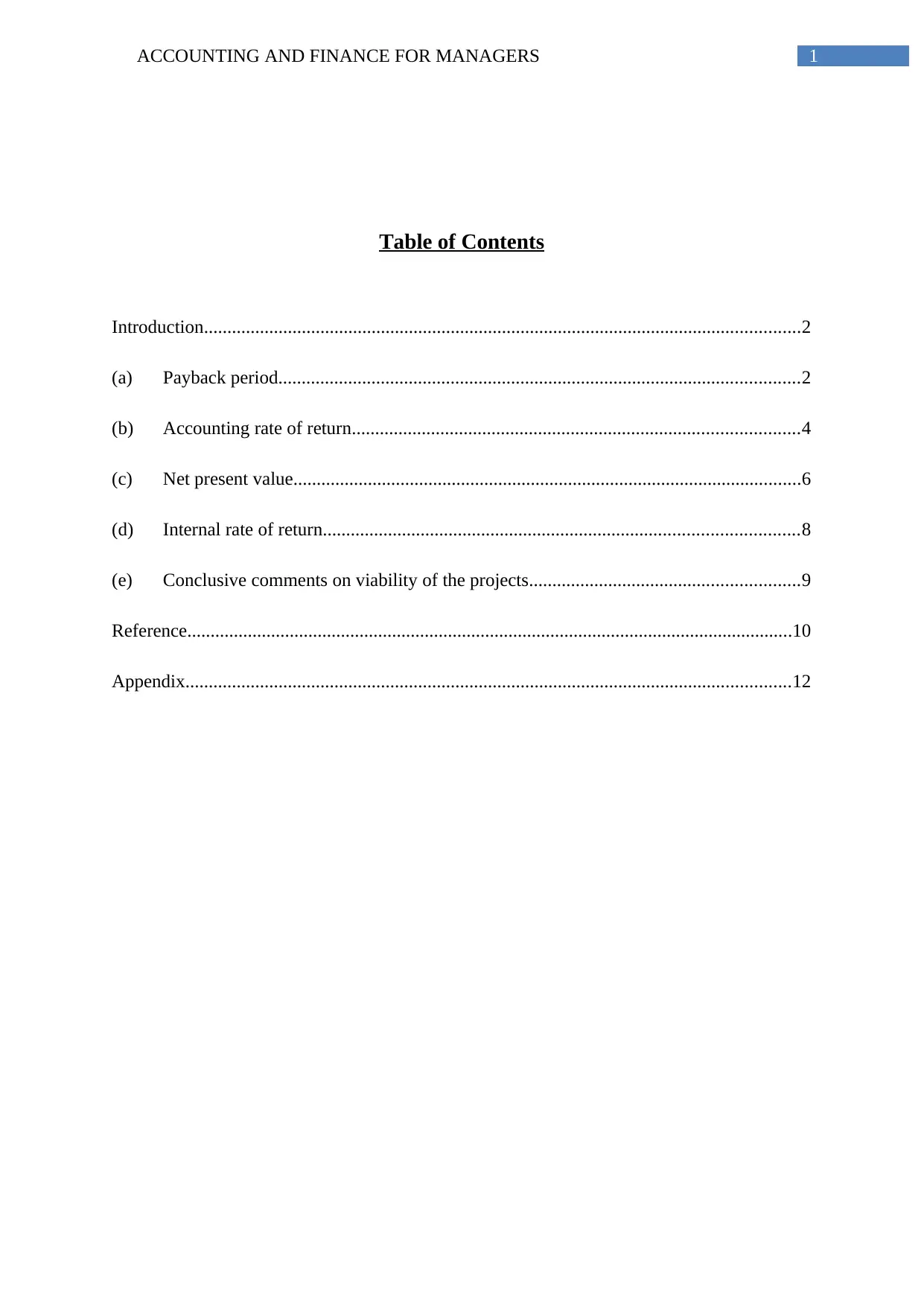
1ACCOUNTING AND FINANCE FOR MANAGERS
Table of Contents
Introduction................................................................................................................................2
(a) Payback period................................................................................................................2
(b) Accounting rate of return................................................................................................4
(c) Net present value.............................................................................................................6
(d) Internal rate of return......................................................................................................8
(e) Conclusive comments on viability of the projects..........................................................9
Reference..................................................................................................................................10
Appendix..................................................................................................................................12
Table of Contents
Introduction................................................................................................................................2
(a) Payback period................................................................................................................2
(b) Accounting rate of return................................................................................................4
(c) Net present value.............................................................................................................6
(d) Internal rate of return......................................................................................................8
(e) Conclusive comments on viability of the projects..........................................................9
Reference..................................................................................................................................10
Appendix..................................................................................................................................12
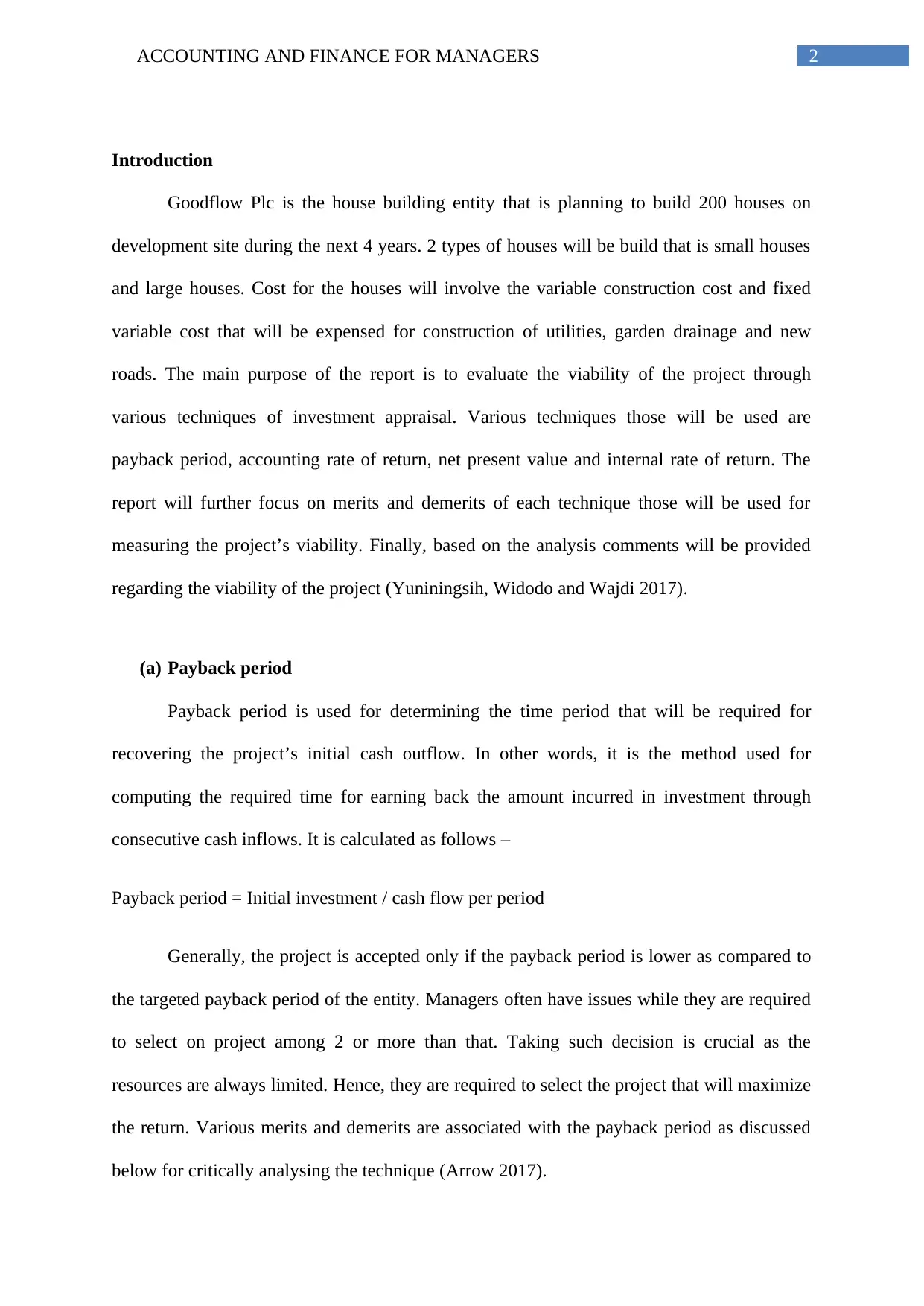
2ACCOUNTING AND FINANCE FOR MANAGERS
Introduction
Goodflow Plc is the house building entity that is planning to build 200 houses on
development site during the next 4 years. 2 types of houses will be build that is small houses
and large houses. Cost for the houses will involve the variable construction cost and fixed
variable cost that will be expensed for construction of utilities, garden drainage and new
roads. The main purpose of the report is to evaluate the viability of the project through
various techniques of investment appraisal. Various techniques those will be used are
payback period, accounting rate of return, net present value and internal rate of return. The
report will further focus on merits and demerits of each technique those will be used for
measuring the project’s viability. Finally, based on the analysis comments will be provided
regarding the viability of the project (Yuniningsih, Widodo and Wajdi 2017).
(a) Payback period
Payback period is used for determining the time period that will be required for
recovering the project’s initial cash outflow. In other words, it is the method used for
computing the required time for earning back the amount incurred in investment through
consecutive cash inflows. It is calculated as follows –
Payback period = Initial investment / cash flow per period
Generally, the project is accepted only if the payback period is lower as compared to
the targeted payback period of the entity. Managers often have issues while they are required
to select on project among 2 or more than that. Taking such decision is crucial as the
resources are always limited. Hence, they are required to select the project that will maximize
the return. Various merits and demerits are associated with the payback period as discussed
below for critically analysing the technique (Arrow 2017).
Introduction
Goodflow Plc is the house building entity that is planning to build 200 houses on
development site during the next 4 years. 2 types of houses will be build that is small houses
and large houses. Cost for the houses will involve the variable construction cost and fixed
variable cost that will be expensed for construction of utilities, garden drainage and new
roads. The main purpose of the report is to evaluate the viability of the project through
various techniques of investment appraisal. Various techniques those will be used are
payback period, accounting rate of return, net present value and internal rate of return. The
report will further focus on merits and demerits of each technique those will be used for
measuring the project’s viability. Finally, based on the analysis comments will be provided
regarding the viability of the project (Yuniningsih, Widodo and Wajdi 2017).
(a) Payback period
Payback period is used for determining the time period that will be required for
recovering the project’s initial cash outflow. In other words, it is the method used for
computing the required time for earning back the amount incurred in investment through
consecutive cash inflows. It is calculated as follows –
Payback period = Initial investment / cash flow per period
Generally, the project is accepted only if the payback period is lower as compared to
the targeted payback period of the entity. Managers often have issues while they are required
to select on project among 2 or more than that. Taking such decision is crucial as the
resources are always limited. Hence, they are required to select the project that will maximize
the return. Various merits and demerits are associated with the payback period as discussed
below for critically analysing the technique (Arrow 2017).
⊘ This is a preview!⊘
Do you want full access?
Subscribe today to unlock all pages.

Trusted by 1+ million students worldwide
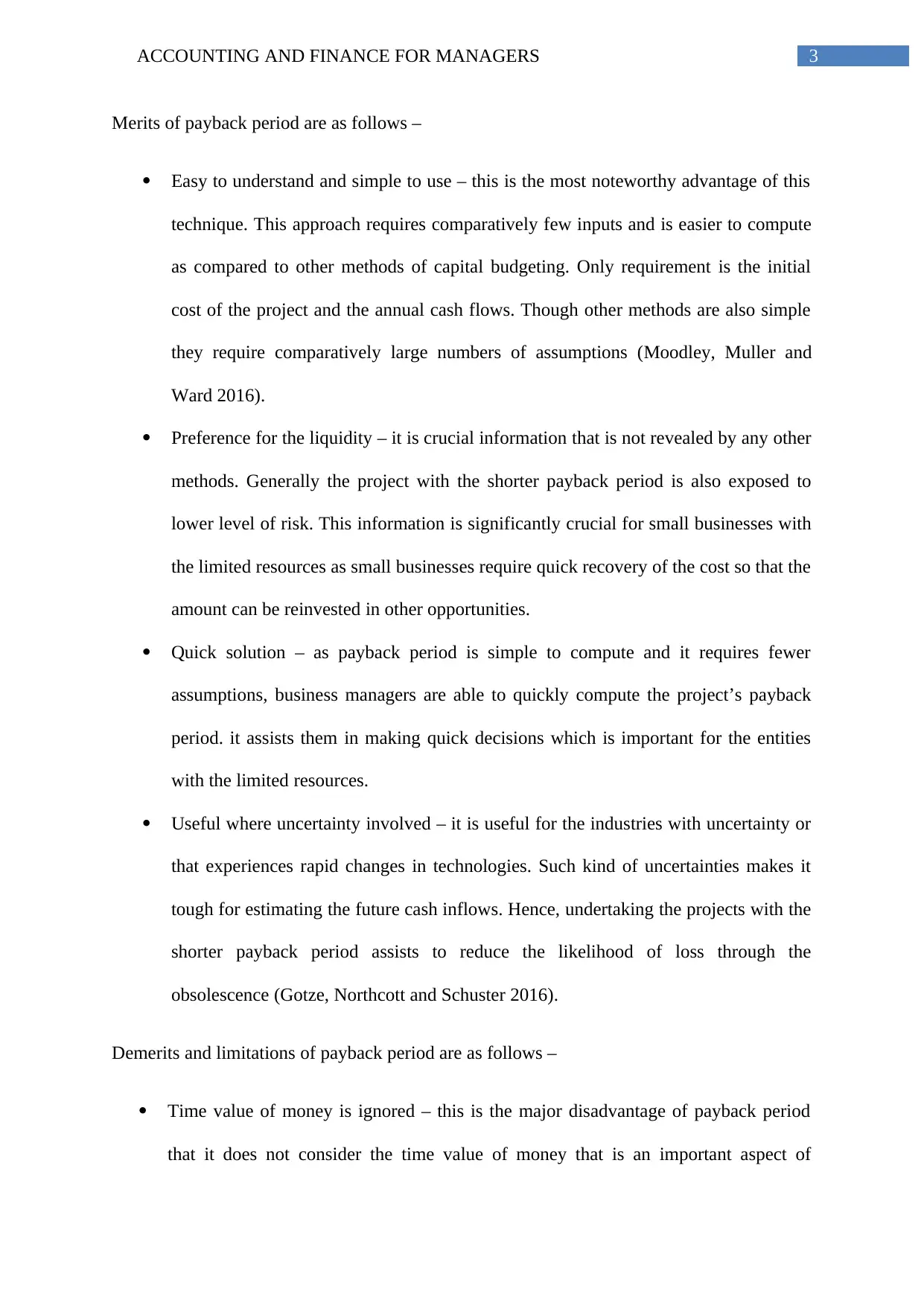
3ACCOUNTING AND FINANCE FOR MANAGERS
Merits of payback period are as follows –
Easy to understand and simple to use – this is the most noteworthy advantage of this
technique. This approach requires comparatively few inputs and is easier to compute
as compared to other methods of capital budgeting. Only requirement is the initial
cost of the project and the annual cash flows. Though other methods are also simple
they require comparatively large numbers of assumptions (Moodley, Muller and
Ward 2016).
Preference for the liquidity – it is crucial information that is not revealed by any other
methods. Generally the project with the shorter payback period is also exposed to
lower level of risk. This information is significantly crucial for small businesses with
the limited resources as small businesses require quick recovery of the cost so that the
amount can be reinvested in other opportunities.
Quick solution – as payback period is simple to compute and it requires fewer
assumptions, business managers are able to quickly compute the project’s payback
period. it assists them in making quick decisions which is important for the entities
with the limited resources.
Useful where uncertainty involved – it is useful for the industries with uncertainty or
that experiences rapid changes in technologies. Such kind of uncertainties makes it
tough for estimating the future cash inflows. Hence, undertaking the projects with the
shorter payback period assists to reduce the likelihood of loss through the
obsolescence (Gotze, Northcott and Schuster 2016).
Demerits and limitations of payback period are as follows –
Time value of money is ignored – this is the major disadvantage of payback period
that it does not consider the time value of money that is an important aspect of
Merits of payback period are as follows –
Easy to understand and simple to use – this is the most noteworthy advantage of this
technique. This approach requires comparatively few inputs and is easier to compute
as compared to other methods of capital budgeting. Only requirement is the initial
cost of the project and the annual cash flows. Though other methods are also simple
they require comparatively large numbers of assumptions (Moodley, Muller and
Ward 2016).
Preference for the liquidity – it is crucial information that is not revealed by any other
methods. Generally the project with the shorter payback period is also exposed to
lower level of risk. This information is significantly crucial for small businesses with
the limited resources as small businesses require quick recovery of the cost so that the
amount can be reinvested in other opportunities.
Quick solution – as payback period is simple to compute and it requires fewer
assumptions, business managers are able to quickly compute the project’s payback
period. it assists them in making quick decisions which is important for the entities
with the limited resources.
Useful where uncertainty involved – it is useful for the industries with uncertainty or
that experiences rapid changes in technologies. Such kind of uncertainties makes it
tough for estimating the future cash inflows. Hence, undertaking the projects with the
shorter payback period assists to reduce the likelihood of loss through the
obsolescence (Gotze, Northcott and Schuster 2016).
Demerits and limitations of payback period are as follows –
Time value of money is ignored – this is the major disadvantage of payback period
that it does not consider the time value of money that is an important aspect of
Paraphrase This Document
Need a fresh take? Get an instant paraphrase of this document with our AI Paraphraser
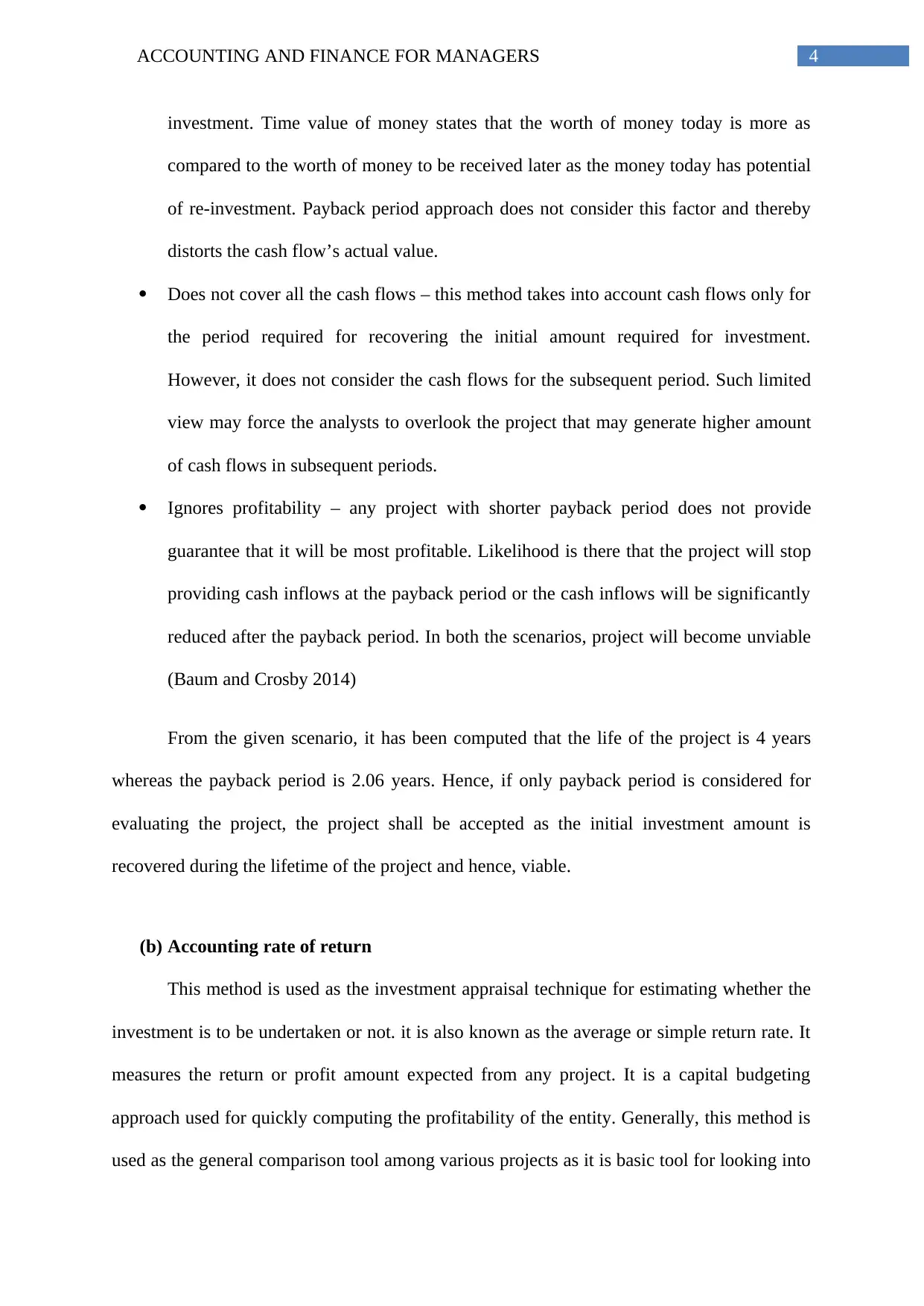
4ACCOUNTING AND FINANCE FOR MANAGERS
investment. Time value of money states that the worth of money today is more as
compared to the worth of money to be received later as the money today has potential
of re-investment. Payback period approach does not consider this factor and thereby
distorts the cash flow’s actual value.
Does not cover all the cash flows – this method takes into account cash flows only for
the period required for recovering the initial amount required for investment.
However, it does not consider the cash flows for the subsequent period. Such limited
view may force the analysts to overlook the project that may generate higher amount
of cash flows in subsequent periods.
Ignores profitability – any project with shorter payback period does not provide
guarantee that it will be most profitable. Likelihood is there that the project will stop
providing cash inflows at the payback period or the cash inflows will be significantly
reduced after the payback period. In both the scenarios, project will become unviable
(Baum and Crosby 2014)
From the given scenario, it has been computed that the life of the project is 4 years
whereas the payback period is 2.06 years. Hence, if only payback period is considered for
evaluating the project, the project shall be accepted as the initial investment amount is
recovered during the lifetime of the project and hence, viable.
(b) Accounting rate of return
This method is used as the investment appraisal technique for estimating whether the
investment is to be undertaken or not. it is also known as the average or simple return rate. It
measures the return or profit amount expected from any project. It is a capital budgeting
approach used for quickly computing the profitability of the entity. Generally, this method is
used as the general comparison tool among various projects as it is basic tool for looking into
investment. Time value of money states that the worth of money today is more as
compared to the worth of money to be received later as the money today has potential
of re-investment. Payback period approach does not consider this factor and thereby
distorts the cash flow’s actual value.
Does not cover all the cash flows – this method takes into account cash flows only for
the period required for recovering the initial amount required for investment.
However, it does not consider the cash flows for the subsequent period. Such limited
view may force the analysts to overlook the project that may generate higher amount
of cash flows in subsequent periods.
Ignores profitability – any project with shorter payback period does not provide
guarantee that it will be most profitable. Likelihood is there that the project will stop
providing cash inflows at the payback period or the cash inflows will be significantly
reduced after the payback period. In both the scenarios, project will become unviable
(Baum and Crosby 2014)
From the given scenario, it has been computed that the life of the project is 4 years
whereas the payback period is 2.06 years. Hence, if only payback period is considered for
evaluating the project, the project shall be accepted as the initial investment amount is
recovered during the lifetime of the project and hence, viable.
(b) Accounting rate of return
This method is used as the investment appraisal technique for estimating whether the
investment is to be undertaken or not. it is also known as the average or simple return rate. It
measures the return or profit amount expected from any project. It is a capital budgeting
approach used for quickly computing the profitability of the entity. Generally, this method is
used as the general comparison tool among various projects as it is basic tool for looking into
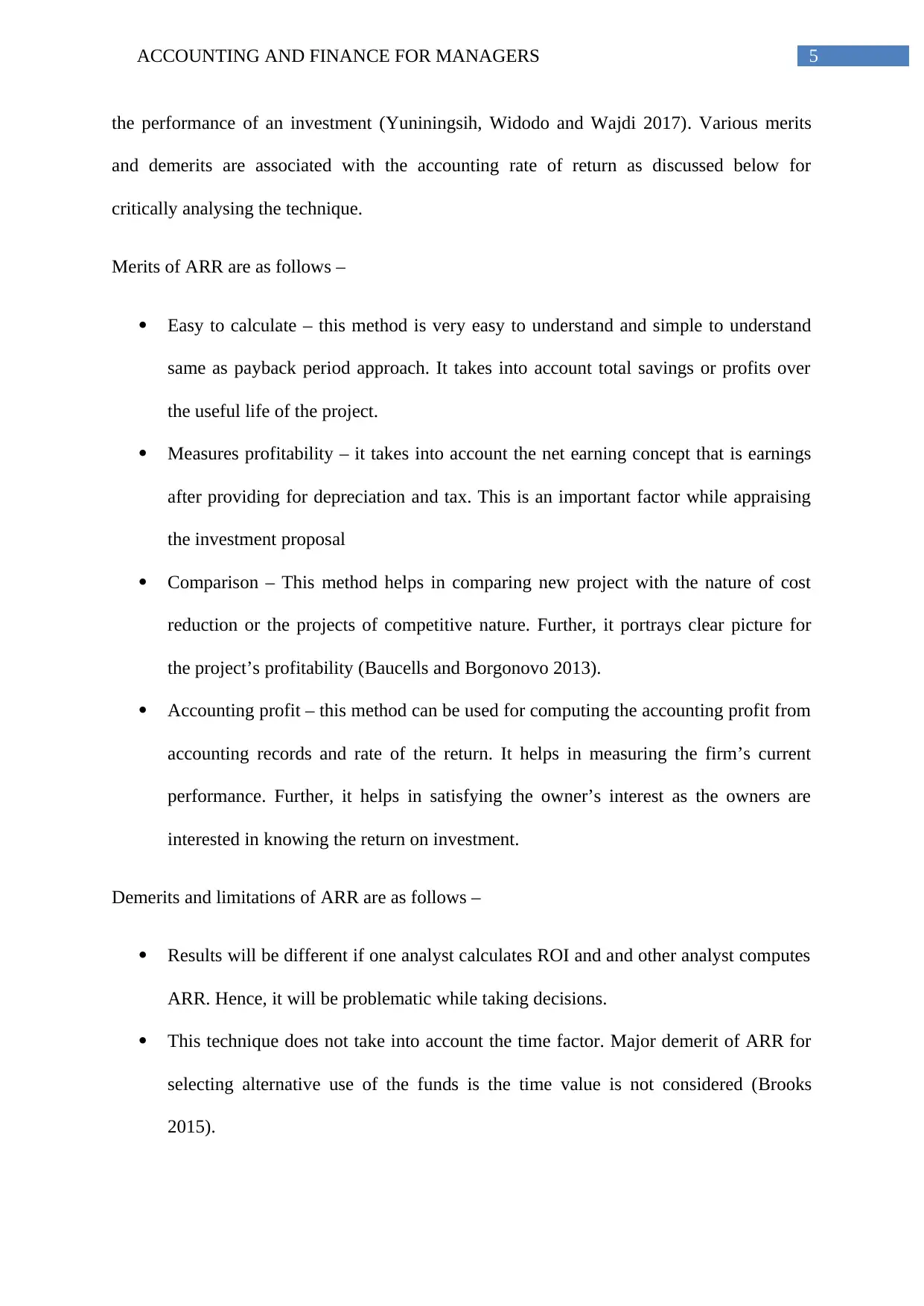
5ACCOUNTING AND FINANCE FOR MANAGERS
the performance of an investment (Yuniningsih, Widodo and Wajdi 2017). Various merits
and demerits are associated with the accounting rate of return as discussed below for
critically analysing the technique.
Merits of ARR are as follows –
Easy to calculate – this method is very easy to understand and simple to understand
same as payback period approach. It takes into account total savings or profits over
the useful life of the project.
Measures profitability – it takes into account the net earning concept that is earnings
after providing for depreciation and tax. This is an important factor while appraising
the investment proposal
Comparison – This method helps in comparing new project with the nature of cost
reduction or the projects of competitive nature. Further, it portrays clear picture for
the project’s profitability (Baucells and Borgonovo 2013).
Accounting profit – this method can be used for computing the accounting profit from
accounting records and rate of the return. It helps in measuring the firm’s current
performance. Further, it helps in satisfying the owner’s interest as the owners are
interested in knowing the return on investment.
Demerits and limitations of ARR are as follows –
Results will be different if one analyst calculates ROI and and other analyst computes
ARR. Hence, it will be problematic while taking decisions.
This technique does not take into account the time factor. Major demerit of ARR for
selecting alternative use of the funds is the time value is not considered (Brooks
2015).
the performance of an investment (Yuniningsih, Widodo and Wajdi 2017). Various merits
and demerits are associated with the accounting rate of return as discussed below for
critically analysing the technique.
Merits of ARR are as follows –
Easy to calculate – this method is very easy to understand and simple to understand
same as payback period approach. It takes into account total savings or profits over
the useful life of the project.
Measures profitability – it takes into account the net earning concept that is earnings
after providing for depreciation and tax. This is an important factor while appraising
the investment proposal
Comparison – This method helps in comparing new project with the nature of cost
reduction or the projects of competitive nature. Further, it portrays clear picture for
the project’s profitability (Baucells and Borgonovo 2013).
Accounting profit – this method can be used for computing the accounting profit from
accounting records and rate of the return. It helps in measuring the firm’s current
performance. Further, it helps in satisfying the owner’s interest as the owners are
interested in knowing the return on investment.
Demerits and limitations of ARR are as follows –
Results will be different if one analyst calculates ROI and and other analyst computes
ARR. Hence, it will be problematic while taking decisions.
This technique does not take into account the time factor. Major demerit of ARR for
selecting alternative use of the funds is the time value is not considered (Brooks
2015).
⊘ This is a preview!⊘
Do you want full access?
Subscribe today to unlock all pages.

Trusted by 1+ million students worldwide
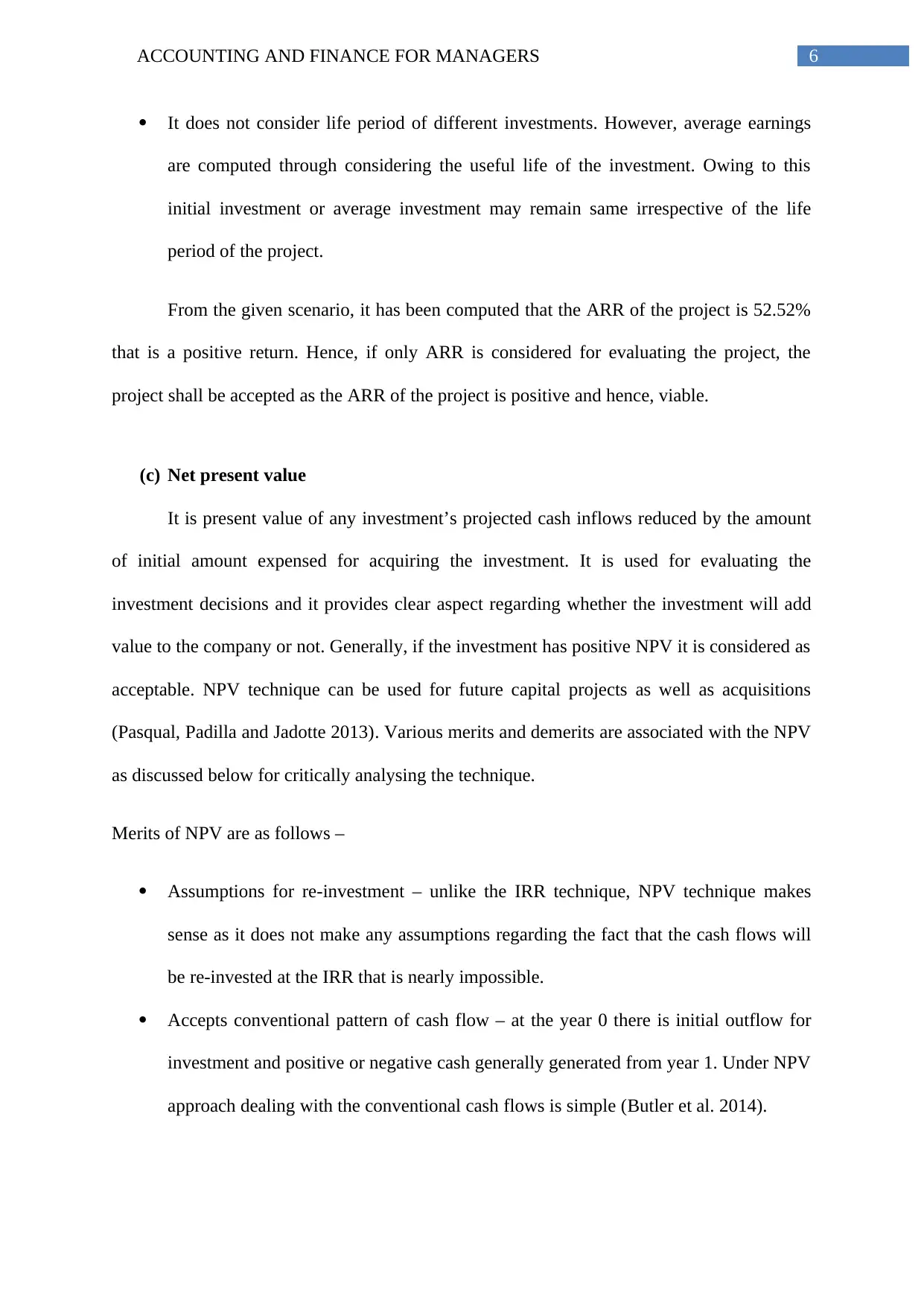
6ACCOUNTING AND FINANCE FOR MANAGERS
It does not consider life period of different investments. However, average earnings
are computed through considering the useful life of the investment. Owing to this
initial investment or average investment may remain same irrespective of the life
period of the project.
From the given scenario, it has been computed that the ARR of the project is 52.52%
that is a positive return. Hence, if only ARR is considered for evaluating the project, the
project shall be accepted as the ARR of the project is positive and hence, viable.
(c) Net present value
It is present value of any investment’s projected cash inflows reduced by the amount
of initial amount expensed for acquiring the investment. It is used for evaluating the
investment decisions and it provides clear aspect regarding whether the investment will add
value to the company or not. Generally, if the investment has positive NPV it is considered as
acceptable. NPV technique can be used for future capital projects as well as acquisitions
(Pasqual, Padilla and Jadotte 2013). Various merits and demerits are associated with the NPV
as discussed below for critically analysing the technique.
Merits of NPV are as follows –
Assumptions for re-investment – unlike the IRR technique, NPV technique makes
sense as it does not make any assumptions regarding the fact that the cash flows will
be re-invested at the IRR that is nearly impossible.
Accepts conventional pattern of cash flow – at the year 0 there is initial outflow for
investment and positive or negative cash generally generated from year 1. Under NPV
approach dealing with the conventional cash flows is simple (Butler et al. 2014).
It does not consider life period of different investments. However, average earnings
are computed through considering the useful life of the investment. Owing to this
initial investment or average investment may remain same irrespective of the life
period of the project.
From the given scenario, it has been computed that the ARR of the project is 52.52%
that is a positive return. Hence, if only ARR is considered for evaluating the project, the
project shall be accepted as the ARR of the project is positive and hence, viable.
(c) Net present value
It is present value of any investment’s projected cash inflows reduced by the amount
of initial amount expensed for acquiring the investment. It is used for evaluating the
investment decisions and it provides clear aspect regarding whether the investment will add
value to the company or not. Generally, if the investment has positive NPV it is considered as
acceptable. NPV technique can be used for future capital projects as well as acquisitions
(Pasqual, Padilla and Jadotte 2013). Various merits and demerits are associated with the NPV
as discussed below for critically analysing the technique.
Merits of NPV are as follows –
Assumptions for re-investment – unlike the IRR technique, NPV technique makes
sense as it does not make any assumptions regarding the fact that the cash flows will
be re-invested at the IRR that is nearly impossible.
Accepts conventional pattern of cash flow – at the year 0 there is initial outflow for
investment and positive or negative cash generally generated from year 1. Under NPV
approach dealing with the conventional cash flows is simple (Butler et al. 2014).
Paraphrase This Document
Need a fresh take? Get an instant paraphrase of this document with our AI Paraphraser
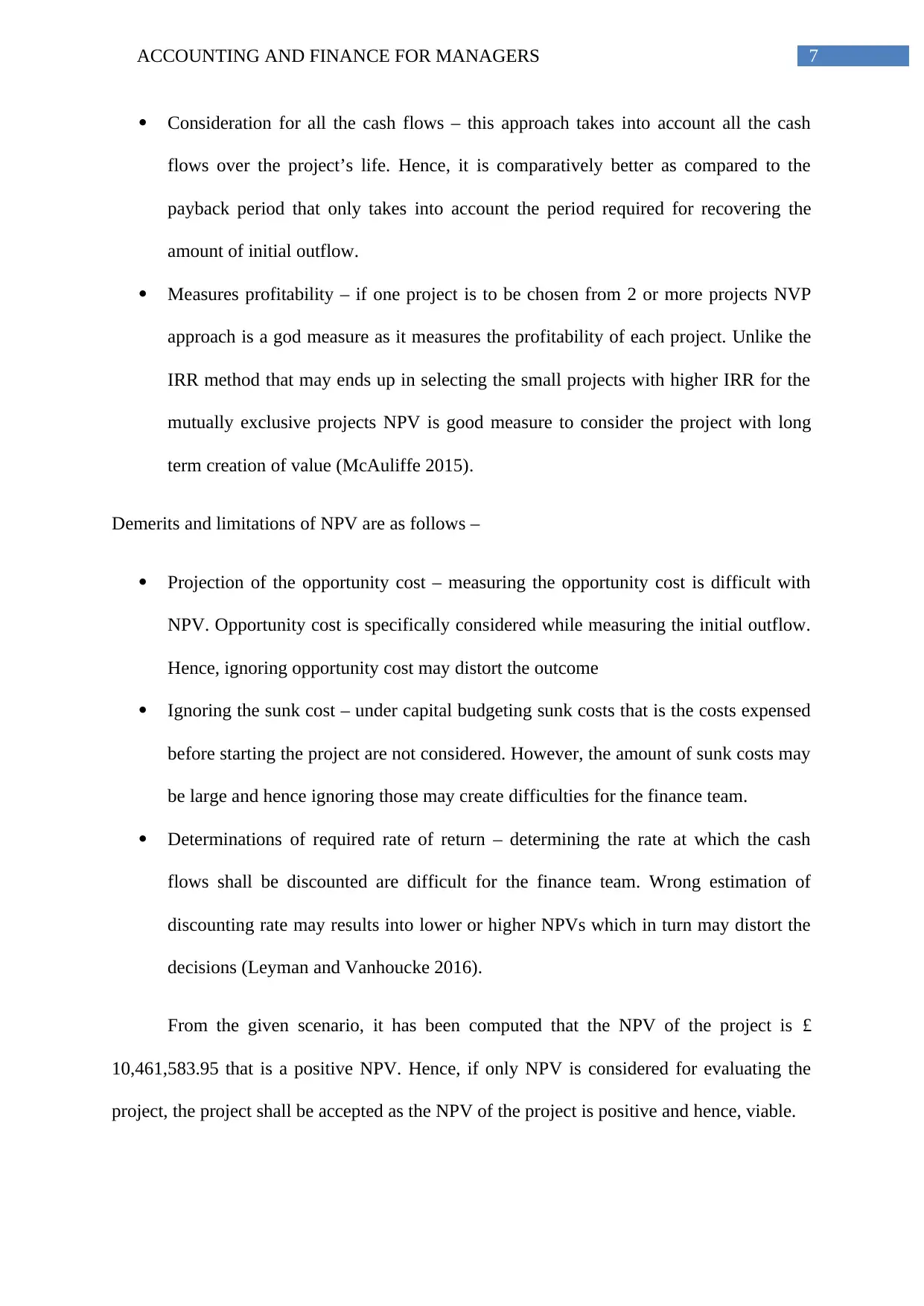
7ACCOUNTING AND FINANCE FOR MANAGERS
Consideration for all the cash flows – this approach takes into account all the cash
flows over the project’s life. Hence, it is comparatively better as compared to the
payback period that only takes into account the period required for recovering the
amount of initial outflow.
Measures profitability – if one project is to be chosen from 2 or more projects NVP
approach is a god measure as it measures the profitability of each project. Unlike the
IRR method that may ends up in selecting the small projects with higher IRR for the
mutually exclusive projects NPV is good measure to consider the project with long
term creation of value (McAuliffe 2015).
Demerits and limitations of NPV are as follows –
Projection of the opportunity cost – measuring the opportunity cost is difficult with
NPV. Opportunity cost is specifically considered while measuring the initial outflow.
Hence, ignoring opportunity cost may distort the outcome
Ignoring the sunk cost – under capital budgeting sunk costs that is the costs expensed
before starting the project are not considered. However, the amount of sunk costs may
be large and hence ignoring those may create difficulties for the finance team.
Determinations of required rate of return – determining the rate at which the cash
flows shall be discounted are difficult for the finance team. Wrong estimation of
discounting rate may results into lower or higher NPVs which in turn may distort the
decisions (Leyman and Vanhoucke 2016).
From the given scenario, it has been computed that the NPV of the project is £
10,461,583.95 that is a positive NPV. Hence, if only NPV is considered for evaluating the
project, the project shall be accepted as the NPV of the project is positive and hence, viable.
Consideration for all the cash flows – this approach takes into account all the cash
flows over the project’s life. Hence, it is comparatively better as compared to the
payback period that only takes into account the period required for recovering the
amount of initial outflow.
Measures profitability – if one project is to be chosen from 2 or more projects NVP
approach is a god measure as it measures the profitability of each project. Unlike the
IRR method that may ends up in selecting the small projects with higher IRR for the
mutually exclusive projects NPV is good measure to consider the project with long
term creation of value (McAuliffe 2015).
Demerits and limitations of NPV are as follows –
Projection of the opportunity cost – measuring the opportunity cost is difficult with
NPV. Opportunity cost is specifically considered while measuring the initial outflow.
Hence, ignoring opportunity cost may distort the outcome
Ignoring the sunk cost – under capital budgeting sunk costs that is the costs expensed
before starting the project are not considered. However, the amount of sunk costs may
be large and hence ignoring those may create difficulties for the finance team.
Determinations of required rate of return – determining the rate at which the cash
flows shall be discounted are difficult for the finance team. Wrong estimation of
discounting rate may results into lower or higher NPVs which in turn may distort the
decisions (Leyman and Vanhoucke 2016).
From the given scenario, it has been computed that the NPV of the project is £
10,461,583.95 that is a positive NPV. Hence, if only NPV is considered for evaluating the
project, the project shall be accepted as the NPV of the project is positive and hence, viable.
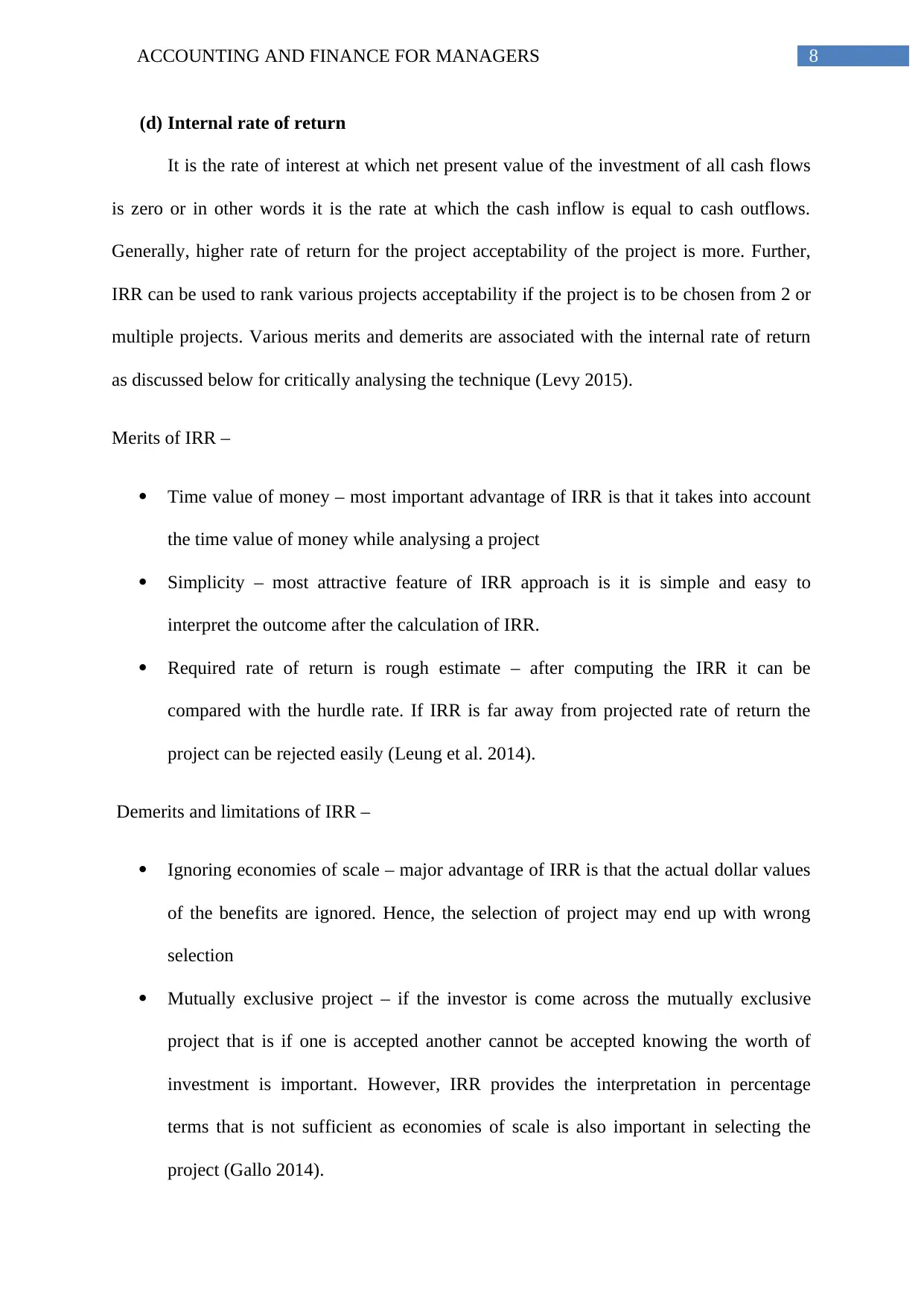
8ACCOUNTING AND FINANCE FOR MANAGERS
(d) Internal rate of return
It is the rate of interest at which net present value of the investment of all cash flows
is zero or in other words it is the rate at which the cash inflow is equal to cash outflows.
Generally, higher rate of return for the project acceptability of the project is more. Further,
IRR can be used to rank various projects acceptability if the project is to be chosen from 2 or
multiple projects. Various merits and demerits are associated with the internal rate of return
as discussed below for critically analysing the technique (Levy 2015).
Merits of IRR –
Time value of money – most important advantage of IRR is that it takes into account
the time value of money while analysing a project
Simplicity – most attractive feature of IRR approach is it is simple and easy to
interpret the outcome after the calculation of IRR.
Required rate of return is rough estimate – after computing the IRR it can be
compared with the hurdle rate. If IRR is far away from projected rate of return the
project can be rejected easily (Leung et al. 2014).
Demerits and limitations of IRR –
Ignoring economies of scale – major advantage of IRR is that the actual dollar values
of the benefits are ignored. Hence, the selection of project may end up with wrong
selection
Mutually exclusive project – if the investor is come across the mutually exclusive
project that is if one is accepted another cannot be accepted knowing the worth of
investment is important. However, IRR provides the interpretation in percentage
terms that is not sufficient as economies of scale is also important in selecting the
project (Gallo 2014).
(d) Internal rate of return
It is the rate of interest at which net present value of the investment of all cash flows
is zero or in other words it is the rate at which the cash inflow is equal to cash outflows.
Generally, higher rate of return for the project acceptability of the project is more. Further,
IRR can be used to rank various projects acceptability if the project is to be chosen from 2 or
multiple projects. Various merits and demerits are associated with the internal rate of return
as discussed below for critically analysing the technique (Levy 2015).
Merits of IRR –
Time value of money – most important advantage of IRR is that it takes into account
the time value of money while analysing a project
Simplicity – most attractive feature of IRR approach is it is simple and easy to
interpret the outcome after the calculation of IRR.
Required rate of return is rough estimate – after computing the IRR it can be
compared with the hurdle rate. If IRR is far away from projected rate of return the
project can be rejected easily (Leung et al. 2014).
Demerits and limitations of IRR –
Ignoring economies of scale – major advantage of IRR is that the actual dollar values
of the benefits are ignored. Hence, the selection of project may end up with wrong
selection
Mutually exclusive project – if the investor is come across the mutually exclusive
project that is if one is accepted another cannot be accepted knowing the worth of
investment is important. However, IRR provides the interpretation in percentage
terms that is not sufficient as economies of scale is also important in selecting the
project (Gallo 2014).
⊘ This is a preview!⊘
Do you want full access?
Subscribe today to unlock all pages.

Trusted by 1+ million students worldwide
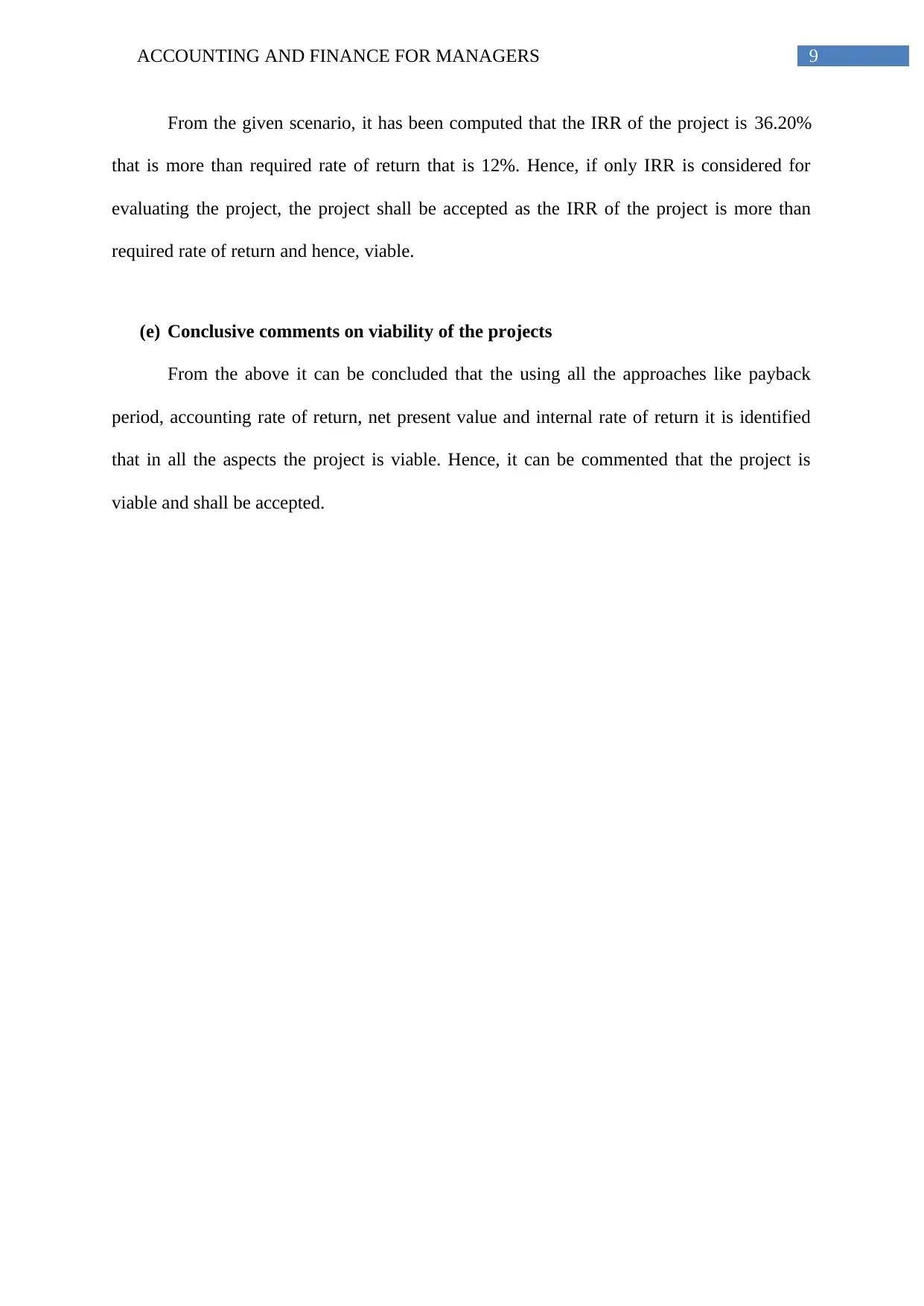
9ACCOUNTING AND FINANCE FOR MANAGERS
From the given scenario, it has been computed that the IRR of the project is 36.20%
that is more than required rate of return that is 12%. Hence, if only IRR is considered for
evaluating the project, the project shall be accepted as the IRR of the project is more than
required rate of return and hence, viable.
(e) Conclusive comments on viability of the projects
From the above it can be concluded that the using all the approaches like payback
period, accounting rate of return, net present value and internal rate of return it is identified
that in all the aspects the project is viable. Hence, it can be commented that the project is
viable and shall be accepted.
From the given scenario, it has been computed that the IRR of the project is 36.20%
that is more than required rate of return that is 12%. Hence, if only IRR is considered for
evaluating the project, the project shall be accepted as the IRR of the project is more than
required rate of return and hence, viable.
(e) Conclusive comments on viability of the projects
From the above it can be concluded that the using all the approaches like payback
period, accounting rate of return, net present value and internal rate of return it is identified
that in all the aspects the project is viable. Hence, it can be commented that the project is
viable and shall be accepted.
Paraphrase This Document
Need a fresh take? Get an instant paraphrase of this document with our AI Paraphraser
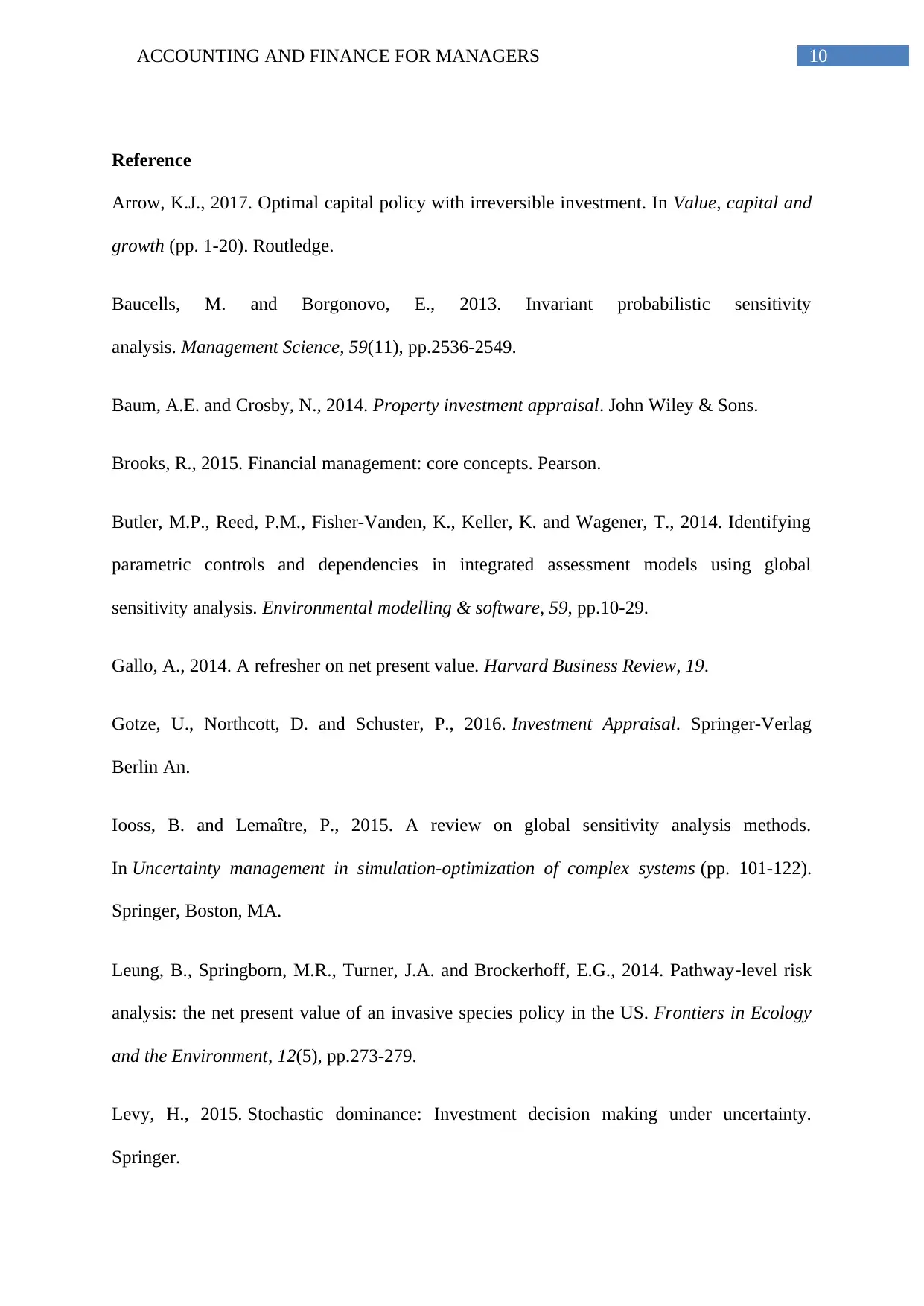
10ACCOUNTING AND FINANCE FOR MANAGERS
Reference
Arrow, K.J., 2017. Optimal capital policy with irreversible investment. In Value, capital and
growth (pp. 1-20). Routledge.
Baucells, M. and Borgonovo, E., 2013. Invariant probabilistic sensitivity
analysis. Management Science, 59(11), pp.2536-2549.
Baum, A.E. and Crosby, N., 2014. Property investment appraisal. John Wiley & Sons.
Brooks, R., 2015. Financial management: core concepts. Pearson.
Butler, M.P., Reed, P.M., Fisher-Vanden, K., Keller, K. and Wagener, T., 2014. Identifying
parametric controls and dependencies in integrated assessment models using global
sensitivity analysis. Environmental modelling & software, 59, pp.10-29.
Gallo, A., 2014. A refresher on net present value. Harvard Business Review, 19.
Gotze, U., Northcott, D. and Schuster, P., 2016. Investment Appraisal. Springer-Verlag
Berlin An.
Iooss, B. and Lemaître, P., 2015. A review on global sensitivity analysis methods.
In Uncertainty management in simulation-optimization of complex systems (pp. 101-122).
Springer, Boston, MA.
Leung, B., Springborn, M.R., Turner, J.A. and Brockerhoff, E.G., 2014. Pathway‐level risk
analysis: the net present value of an invasive species policy in the US. Frontiers in Ecology
and the Environment, 12(5), pp.273-279.
Levy, H., 2015. Stochastic dominance: Investment decision making under uncertainty.
Springer.
Reference
Arrow, K.J., 2017. Optimal capital policy with irreversible investment. In Value, capital and
growth (pp. 1-20). Routledge.
Baucells, M. and Borgonovo, E., 2013. Invariant probabilistic sensitivity
analysis. Management Science, 59(11), pp.2536-2549.
Baum, A.E. and Crosby, N., 2014. Property investment appraisal. John Wiley & Sons.
Brooks, R., 2015. Financial management: core concepts. Pearson.
Butler, M.P., Reed, P.M., Fisher-Vanden, K., Keller, K. and Wagener, T., 2014. Identifying
parametric controls and dependencies in integrated assessment models using global
sensitivity analysis. Environmental modelling & software, 59, pp.10-29.
Gallo, A., 2014. A refresher on net present value. Harvard Business Review, 19.
Gotze, U., Northcott, D. and Schuster, P., 2016. Investment Appraisal. Springer-Verlag
Berlin An.
Iooss, B. and Lemaître, P., 2015. A review on global sensitivity analysis methods.
In Uncertainty management in simulation-optimization of complex systems (pp. 101-122).
Springer, Boston, MA.
Leung, B., Springborn, M.R., Turner, J.A. and Brockerhoff, E.G., 2014. Pathway‐level risk
analysis: the net present value of an invasive species policy in the US. Frontiers in Ecology
and the Environment, 12(5), pp.273-279.
Levy, H., 2015. Stochastic dominance: Investment decision making under uncertainty.
Springer.
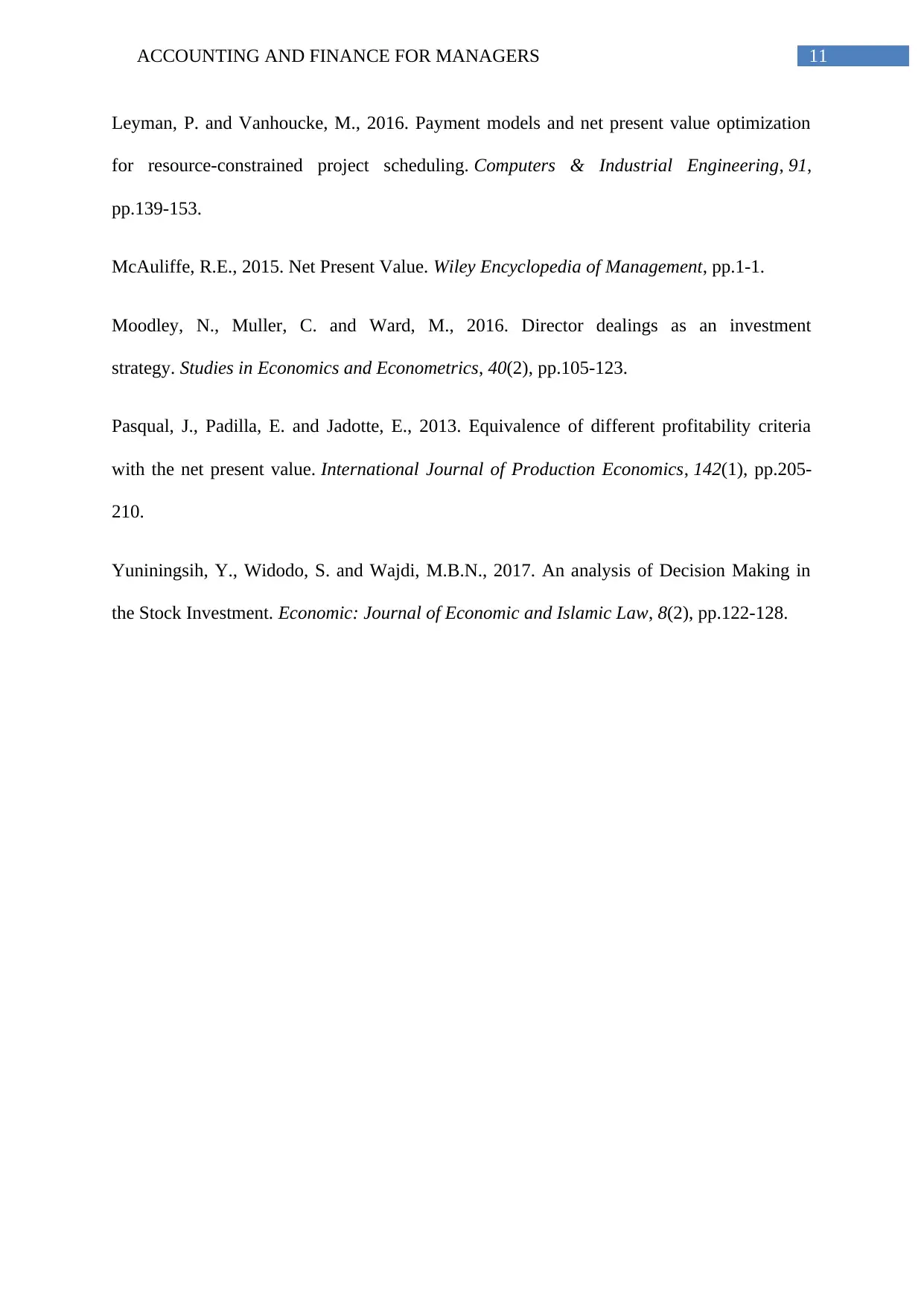
11ACCOUNTING AND FINANCE FOR MANAGERS
Leyman, P. and Vanhoucke, M., 2016. Payment models and net present value optimization
for resource-constrained project scheduling. Computers & Industrial Engineering, 91,
pp.139-153.
McAuliffe, R.E., 2015. Net Present Value. Wiley Encyclopedia of Management, pp.1-1.
Moodley, N., Muller, C. and Ward, M., 2016. Director dealings as an investment
strategy. Studies in Economics and Econometrics, 40(2), pp.105-123.
Pasqual, J., Padilla, E. and Jadotte, E., 2013. Equivalence of different profitability criteria
with the net present value. International Journal of Production Economics, 142(1), pp.205-
210.
Yuniningsih, Y., Widodo, S. and Wajdi, M.B.N., 2017. An analysis of Decision Making in
the Stock Investment. Economic: Journal of Economic and Islamic Law, 8(2), pp.122-128.
Leyman, P. and Vanhoucke, M., 2016. Payment models and net present value optimization
for resource-constrained project scheduling. Computers & Industrial Engineering, 91,
pp.139-153.
McAuliffe, R.E., 2015. Net Present Value. Wiley Encyclopedia of Management, pp.1-1.
Moodley, N., Muller, C. and Ward, M., 2016. Director dealings as an investment
strategy. Studies in Economics and Econometrics, 40(2), pp.105-123.
Pasqual, J., Padilla, E. and Jadotte, E., 2013. Equivalence of different profitability criteria
with the net present value. International Journal of Production Economics, 142(1), pp.205-
210.
Yuniningsih, Y., Widodo, S. and Wajdi, M.B.N., 2017. An analysis of Decision Making in
the Stock Investment. Economic: Journal of Economic and Islamic Law, 8(2), pp.122-128.
⊘ This is a preview!⊘
Do you want full access?
Subscribe today to unlock all pages.

Trusted by 1+ million students worldwide
1 out of 14
Related Documents
Your All-in-One AI-Powered Toolkit for Academic Success.
+13062052269
info@desklib.com
Available 24*7 on WhatsApp / Email
![[object Object]](/_next/static/media/star-bottom.7253800d.svg)
Unlock your academic potential
Copyright © 2020–2025 A2Z Services. All Rights Reserved. Developed and managed by ZUCOL.





